Hiking, camping, etc…. are beloved outdoor activities that let us discover nature’s beauties. Heat-related disorders, notably heat stroke, become more dangerous as temperatures increase. Heat stroke is a dangerous and sometimes fatal illness that may develop when being exposed to hot weather.
To guarantee a safe and pleasurable hiking experience, outdoor enthusiasts must grasp the signs, symptoms, and preventative actions in preventing heat stroke. This article will discuss heat stroke, its dangers, and how hikers should keep cool, hydrated, and aware.
Preventing Heat Stroke When Hiking
Understanding Heat Stroke:
Heat stroke is a severe and sometimes fatal heat-related sickness when the body’s core temperature increases dangerously. It’s an urgent medical situation requiring immediate care. Here’s a deeper look at heat stroke and its potentially fatal consequences:
Heat stroke happens when the body’s normal cooling systems, such as sweating and radiating heat, fail to control its temperature efficiently. This may cause the body’s core temperature to rise over 104 degrees Fahrenheit (40 degrees Celsius).
• Heat stroke may be fatal, affecting many organ systems in the body. If untreated, it may result in:
• Brain damage, such as disorientation, convulsions, or loss of consciousness.
• Organ failure, such as kidney, liver, or heart failure.
• Muscle breakdown, resulting in the release of toxic proteins into the circulation.
• The possibility of life-threatening complications or death.
It is critical to distinguish between heat exhaustion and heat stroke. Heat Exhaustion is a weaker form of heat disease marked by excessive perspiration, weakness, dizziness, and nausea. While heat exhaustion can lead to heat stroke if left untreated, it does not usually include the same amount of organ damage or life-threatening conditions.
When a body temperature exceed 104 degrees Fahrenheit, disorientation, altered mental state, or loss of consciousness are signs of heat stroke, a more serious condition. Heat stroke needs prompt medical treatment.
Hiking may cause heat stroke due to high temperatures and humidity, intense physical exercise without breaks and hydration, insufficient fluid intake, prolonged sun exposure and dressing inappropriately, such as in dark colors or layers.
Understanding the severity of heat stroke, distinguishing it from heat exhaustion, and understanding the risk factors are critical steps in avoiding this severe illness when hiking.
Recognizing the Signs of Heat Stroke:
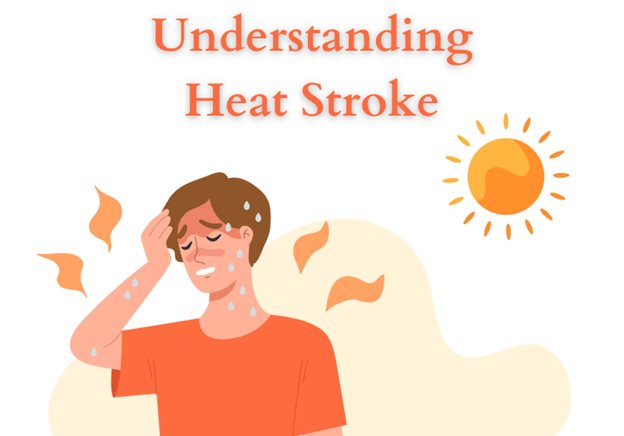
Heat stroke may cause physical as well as behavioral problems. Understanding these warning indicators is crucial for early detection and management.
Physical Symptoms:
A severely raised body temperature, sometimes surpassing 104 degrees Fahrenheit (40 degrees Celsius), is one of the key physical indicators of heat stroke. This elevated temperature indicates the body’s inability to cool down efficiently.
Another typical physical symptom is a quick heartbeat, sometimes known as tachycardia. Tachycardia is a condition where the heart works faster to circulate blood and disperse heat. Heat stroke may create hot, dry, and flushed skin, in contrast to the wet skin seen in heat exhaustion. Sweating could stop entirely, suggesting a malfunction in the body’s cooling process.
When the body overheats, it may cause nausea and vomiting as a defense mechanism. Due to heat stroke, hikers may have severe headaches, dizziness, or lightheadedness.
Heat stroke symptoms may quickly increase from moderate to severe. A hiker, for example, may first feel heat exhaustion symptoms such as excessive perspiration and weakness. Without treatment, these symptoms may lead to heat stroke, which causes disorientation, unconsciousness, and possibly fatal organ damage.
Behavioral Symptoms:
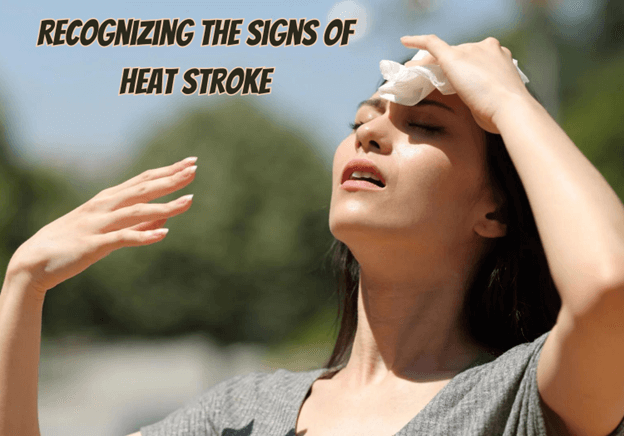
Confusion, changed mental state, and disorientation are behavioral symptoms of heat stroke. Hikers may need help with thinking clearly or following directions. Heat stroke may cause irritation and mood changes, causing somebody to become angry or unreasonable.
Behavioral symptoms are important to identify since they often reflect the severity of heat stroke and the need for prompt medical intervention. When a hiker becomes disoriented, unresponsive, or anxious, heat stroke is advanced, and brain and organ damage is possible.
Risk Factors for Heat Stroke:
Individual and environmental variables may influence heat stroke risk factors. When hiking, it’s important to be aware of these frequent dangers.
Hot temperatures considerably increase heat stroke, particularly during the summer months. High temperatures may cause the body’s cooling systems to fail. Humidity makes perspiration evaporate more slowly, decreasing the body’s capacity to cool down. Heat-related diseases may result.
Internal heat is produced by intense physical effort, such as severe trekking or carrying heavy loads. The greater the intensity of the exercise, the greater the danger of heat stroke. Dehydration makes it difficult for the body to sweat and cool itself. Hikers drinking insufficient water are more likely to suffer from heat-related ailments.
Individuals unfamiliar with hot weather or high altitudes may be more prone to heat stroke. Heavy or improper clothes, such as dark colors or several layers, can block heat spread and raise the danger of overheating. Hiking in locations with little shade exposes trekkers to direct sunshine, causing heat exhaustion.
Assessing Personal Risk Before a Hike:
Determining your risk of heat stroke before going on a walk is critical. Be informed of the weather prediction for your trekking day. If possible, avoid trekking during intense heat or heavy humidity.
Examine your physical fitness and heat acclimation. Plan hikes appropriate for your fitness level and progressively increase your endurance.
Ensure you’re well-hydrated before beginning your journey, and bring plenty of water. Even if you don’t feel thirsty, drink plenty of water while hiking. Dress for the temperature and the amount of exercise. Wear lightweight, breathable clothes and a hat with a broad brim.
Examine the trail’s difficulty rating and elevation increase. Choose paths that are appropriate for your level of expertise and fitness. You may avoid heat stroke while hiking by considering these risk factors and taking precautions.
Pre-Hike Preparations
Thorough pre-hike preparations may lower the risk of heat stroke before starting a trek. Here are some things to think about:
Planning Your Hike:
Choose a path that is appropriate for your level of fitness and expertise. If you are not fully prepared, avoid difficult treks. Plan your trek at a cooler time, such as early morning or late afternoon. Avoid trekking during the noon heat.
Check the weather forecast for the area before you go on your trek. Hiking should be avoided on very hot days or during heatwaves. Examine trail conditions, closures, and any specific recommendations or warnings. Look for any recent wildfires or natural disasters in the region.
Set achievable goals depending on your fitness level, the complexity of the path, and the predicted weather conditions. Don’t overexert yourself by taking on a trek above your skills.
Gear and Clothing:
1. Essential Gear for Preventing Heat Stroke:
• Lightweight, moisture-wicking apparel that covers your skin yet is breathable to regulate body temperature.
• A hat with a wide brim to save your face and neck from direct sunlight.
• A high-SPF sunscreen of excellent quality to protect exposed skin.
• UV-protected sunglasses to protect your eyes from dangerous UV radiation.
• Hiking boots or shoes with enough airflow to keep your feet cool.
2. Clothing Options and Their Impact on Body Temperature:
• Wear light-colored clothing that reflects instead of absorbs sunlight. Dark colors retain heat, raising your body temperature.
• Choose moisture-wicking and breathable fabrics, allowing perspiration to drain and keeping you cool.
• Wear long sleeves and lightweight slacks to guard against sunburn and to limit direct sun exposure.
3. Hiker’s Hiking Gear Checklist:
• Before you begin the path, make sure you have the following items:
• An enough quantity of water (hydration pack or water bottles)
• A map of the trail or a GPS device
• Fully charged mobile phone
• A first-aid kit with materials for heat-related ailments.
• Insect repellent (if necessary)
• Navigational gears such as a compass or GPS
• A whistle or similar signaling device
• An additional pair of clothing in case of sudden weather changes
Plan your trek, choose the correct gear and clothes, and be aware of weather and trail conditions to improve safety and reduce heat stroke risk.
Staying Hydrated
Hydration is vital to hiking, and recognizing its significance is critical for avoiding heat-related ailments such as heat stroke.
Hydration Basics:
Water is essential to the human body for various crucial activities such as temperature control, digestion, and circulation. Water also aids in the removal of waste and poisons from the body.
The body sweats to disperse heat after physical exercise, particularly in hot weather. Sweat includes electrolytes and water, and its evaporation cools the body.
The daily recommended water consumption ranges from 8 to 12 cups (64 to 96 ounces) for adults, depending on characteristics such as age, gender, activity level, and climate. Hiking increases your water requirements greatly owing to sweat loss and increased physical exertion.
Hiking in hot temperatures may cause significant fluid loss via sweating. Depending on the circumstances, you may need to drink up to half a liter (17 ounces) of water every hour or more to keep hydrated. Your water requirements are also influenced by factors such as your body size, fitness level, and the intensity and length of the climb.
It’s critical to expose popular misconceptions, such as the notion that feeling thirsty is a reliable sign of hydration. If you’re thirsty, it’s probably too late.
Another common myth is that drinking a lot of water is always helpful. While remaining hydrated is important, overhydration may result in hyponatremia, a condition in which the electrolyte balance in your body is upset.
Hydration During Hikes:
Drink water before you begin your trek to stay hydrated. Use a hydration device, such as a hydration bladder or easily accessible water bottles, to guarantee that you may consume water regularly without pausing.
Instead of waiting until you’re thirsty, drink water often throughout your journey. Be mindful of indicators of dehydration, such as dark urine or decreased urination, and treat them as soon as possible.
Hydration devices, such as backpack hydration bladders, enable hikers to drink hands-free while on the go, promoting constant hydration.
Drink tiny sips of water often, ideally every 15-20 minutes. A common rule of thumb is to drink half a liter (17 ounces) of water every hour. However, this should be adjusted depending on your body’s demands and the surroundings. In particularly hot or dry weather, you may need to increase your water consumption significantly.
Staying hydrated is critical for avoiding heat stroke and having a safe and enjoyable hiking trip. Hikers may prevent heat-related diseases and remain in top shape by knowing hydration science, following practical rules, and utilizing proper hydration devices.
Recognizing Early Warning Signs
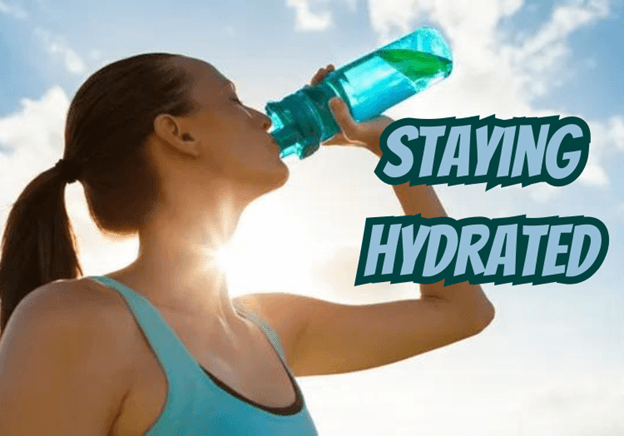
Recognizing warning signs of heat-related disorders, such as heat stroke, is critical for prompt prevention. Here’s how hikers may keep an eye on their bodies and remain alert:
Monitoring Your Body:
During a trek, paying attention to your body’s signals is critical. Your body often gives you early warning indications that anything is amiss, enabling you to treat problems before they become serious.
Take frequent pauses to examine your mood. Use these pauses to assess your physical and mental health. Take note of your body’s temperature. If you suddenly get excessively hot, this might be a warning sign of heat stroke.
Keep an eye on your heart rate. A particularly fast pulse might suggest heat stress. Check your urine color to determine your hydration level. Dehydration is indicated by dark yellow or orange urine.
Early warning signals of heat-related problems include:
• Sweating excessively or not sweating at all.
• Muscle spasms or cramps.
• Nausea, dizziness, or feeling light-headed.
• Dizziness, irritability, or a change in mental state.
• Fast heartbeat.
• Tiredness or weakness.
• Urine that is dark in color.
You must act quickly if you or a hiking companion encounter any of these symptoms.
Buddy System:
Hiking with a friend or group is strongly encouraged, particularly in difficult or isolated places. Having a trekking buddy has various benefits, including safety and assistance in an emergency.
Hiking companions may watch for signs of heat stroke or other heat-related difficulties in each other, frequently noting symptoms that the sick person is unaware of. A trekking companion may provide support, carry extra water, and assist with first aid if necessary.
Share experiences or stories regarding how hiking companions have come to each other’s rescue in times of need due to heat. These real-life examples demonstrate the importance of the buddy system.
The buddy system improves safety and encourages friendship and mutual support among hikers. Having someone see early warning symptoms reduces the danger of heat stroke and other heat-related disorders on treks.
First Aid for Heat Stroke
Immediate Response:
If you fear someone is suffering from heat stroke while hiking, you must intervene promptly. Heat stroke is a medical urgency that requires rapid treatment. Call 911 or your local emergency number as soon as possible. Inform them of the possible heat stroke.
While you wait for aid, prioritize the person’s safety and start cooling procedures. If feasible, move the sick individual to a cooler, shaded spot away from direct sunshine. To help the body cool down more efficiently, loosen or remove any redundant clothes, such as outer layers.
Cooling Techniques:
After you’ve done these first aids, you may use cooling strategies to reduce the person’s body temperature. It is critical to act quickly and consistently until expert assistance comes.
If possible, place the individual in the shade or inside. Maintain enough airflow to help in cooling. Soak the individual’s garments with cold water. Apply water to their skin using a towel, sponge, or water bottle.
Place ice or cold packs beneath the person’s armpits, neck, and groin region if you have them. Cooling may be particularly effective in locations with big blood vessels.
To improve evaporative cooling, use a fan or produce airflow using a portable fan or fanning the individual with a piece of cardboard or clothes. Immerse the individual in chilly (not ice-cold) water if a water source is available and safe. Submerge their whole body, including their arms, legs, and chest.
Agitate the water continuously to increase cooling efficiency. Keep an eye on their vital signs and modify the water temperature to minimize shivering, which may cause body heat to rise. If the person is awake and can drink, offer them chilled, non-alcoholic liquids. Water or electrolyte solutions may aid in rehydrating and cooling the body from the inside.
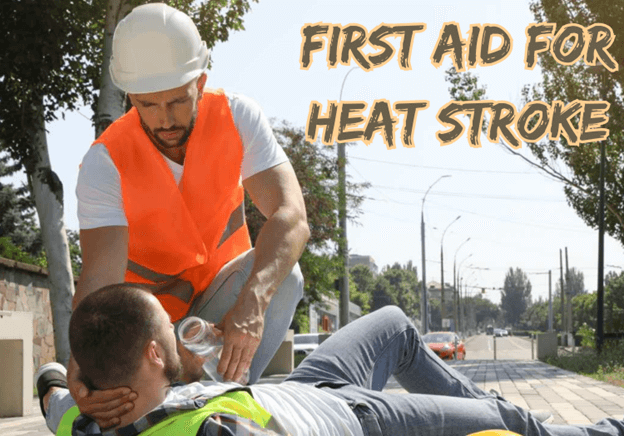
Limitations of Home-Based Cooling Methods:
While these at-home cooling treatments may be useful in lowering body temperature, they may be limited in severe instances of heat stroke. Professional medical involvement is required to give advanced treatment, such as intravenous fluids and monitoring.
Always remember that the main objective is to reduce the person’s body temperature as quickly as possible to avoid additional organ damage. Heat stroke may be fatal; therefore, obtaining urgent medical attention is critical for the best result.
Post-Hike Recovery and Evaluation
Your activities immediately after a hike or walk may greatly influence your well-being and future experiences.
After the Hike:
When you go back to your starting place, prioritize two things: rehydration and relaxation. To fight dehydration, replenish lost fluids by consuming water or electrolyte-rich drinks. This is particularly important if the trip is difficult or hot. Rest is also necessary to enable your body to heal. Take it easy for the rest of the day if you are tired or have muscular discomfort.
Your responsibilities, however, do not cease when you leave the path. Even after the trek is over, it’s critical to keep an eye out for any residual effects. While most treks end without incident, some circumstances may demand expert medical assistance.
Seeking prompt healthcare is critical if you or a fellow hiker suffer signs of heat-related diseases, severe dehydration, injuries, persistent symptoms such as acute exhaustion or disorientation, or allergic reactions.
Reflecting on Your Hike:
Hiking isn’t only about conquering paths; it’s also about personal development and ongoing progress. Encourage hikers to think about their performance and choices while on the trail. What went well, and what might have gone better?
Consider keeping a hiking notebook or using hike-tracking apps for self-evaluation. Take notes on route conditions, weather, and your mental state during the trek. This helps you remember the great times you had in the great outdoors and shows you where you may improve.
Set objectives for your future treks, whether they be to improve your fitness, refine your pacing tactics, or master new outdoor abilities. The more you learn on each walk, the more prepared you will be for your next trip. By following these rules, you ensure a safe and delightful hiking trip and go on a road of personal development and outdoor mastery.
Additional Resources
If you are looking for more tutorials, walkthroughs and troubleshooting about camping and enjoying the outdoors, here are some additional posts to check out:
Conclusion:
Finally, detecting and avoiding heat stroke when hiking is essential for anybody travelling in the environment. The great outdoors provides fantastic pleasures but may also pose major dangers, particularly in hot and harsh weather.
Understanding the indications of heat stroke, identifying the risk factors, and adopting preventative actions will help you and your fellow hikers stay safe. Prioritize appropriate hydration, planning, and self-awareness at all times. In the case of a heat-related emergency, remember that immediate action may save your life.
Hiking should be a fun and exciting adventure, and by being aware and watchful, you can guarantee that every trip into nature is safe and enjoyable. Share your expertise, encourage your hiking partners, and help build a community of responsible outdoor lovers who value safety as much as pleasure. Thanks for reading, if you think I forgot something or simply want to share a story or some advice, feel free to leave your comment below. Be safe and have fun.!

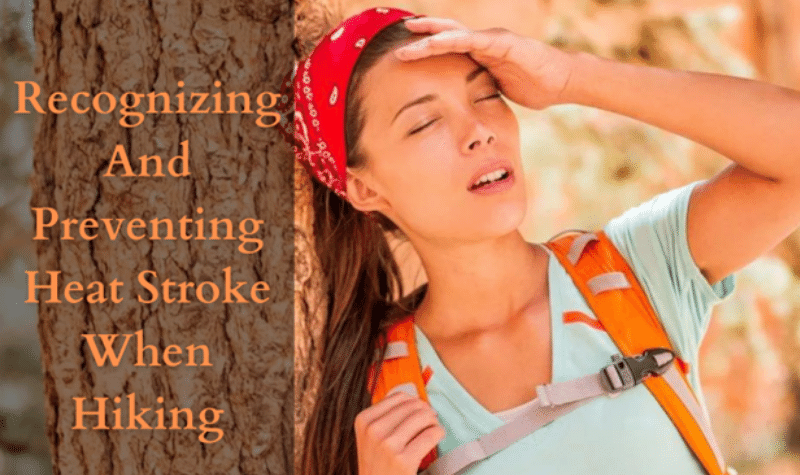
Thank you for your valuable addition.
Thank you for such a wonderful article Go 2 fishing
Thank you my friend, I am only trying to help all of us, The Outdoor Lovers